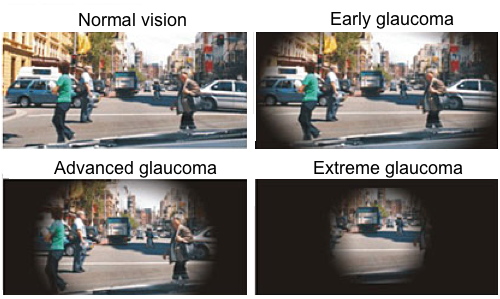The week of March 11 is World Glaucoma Week. Glaucoma is a serious condition that merits serious attention. It’s time for a recap of the extensive information that VisionAware offers about glaucoma.
Glaucoma often is called "the sneak thief of sight" for good reason: Many people are unaware that glaucoma has few symptoms or warning signs in its early stages. Early treatment for glaucoma can usually (but not always) slow the progression of the disease. However, as of yet, there is no cure for glaucoma.

The typical progression of vision loss from glaucoma
Source: National Eye Institute
A Few Important Facts About Glaucoma
- Glaucoma affects more than 3 million people living in the United States.
- Glaucoma is a leading cause of blindness in African Americans, who should begin glaucoma tests as early as age 35.
- Glaucoma has many causes, and elevated eye pressure is a factor in most. Pressure builds up in the eye due to problems with drainage of aqueous, a fluid produced in the eye.
- Glaucoma is particularly dangerous to your vision because there are usually no noticeable symptoms initially. A comprehensive dilated eye exam is critical to detect changes that occur early in the optic nerve
You can find more facts on VisionAware.
Glaucoma results in a loss of peripheral or side vision initially, which affects your ability to move about safely. Over time, glaucoma can damage your central vision as well.
What Is A Dilated Eye Exam?
A dilated eye exam is a painless exam that uses eye drops to enlarge (dilate) the pupils in order to allow more light to enter the eyes. Once the pupils are dilated, important tissues at the back of the eye—including the retina, the macula, and the optic nerve—can be examined for signs of disease. Be sure to read about the other tests that doctors use in addition to a dilated eye exams. Be aware that glaucoma screening for eye pressure has been determined by U.S. Preventive Services Task Force not to be effective by itself for detecting primary open-angle glaucoma. The most common type of glaucoma is Primary Open-Angle Glaucoma (POAG). In POAG, the eye’s drainage canals become blocked, and the fluid accumulation causes pressure to build within the eye. This pressure can cause damage to the optic nerve, which transmits information from the eye to the brain.
There are several other types of glaucoma: narrow closure, normal tension, and secondary glaucoma. All of these are detailed in our article on types of glaucoma.
Treatments for Glaucoma
Treatments span the gamut of eye drops, surgery, and laser. There is a good deal of research going on, tracked by the Glaucoma Research Foundation. The VisionAware Blog covers new research from time to time as well. And, yes, stem cell trials are being planned, genetic research is underway, and a host of new medication and surgical treatments are being tried along with new clinical trials.
Coping with Glaucoma
Several individuals have written for VisionAware about their experiences with living with glaucoma, the importance of strictly following your doctor’s treatment plan, and also the need for obtaining vision rehabilitation services if vision loss occurs. Here are of some of their stories:
Tom McCarville’s Personal Story
Joe Lovett’s Personal Story About "Going Blind"
Additional Information on Glaucoma
Learn More About Glaucoma and Current Treatments